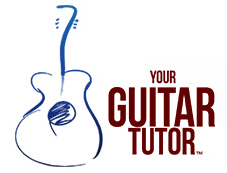Hi there, this lesson is all about rhythmic notation and why having a grasp of it will benefit your guitar playing and allow you to express yourself through the guitar more easily.
Rhythmic Notation and TAB
Rhythm could be described as accented groupings of time and it forms the basis of everything we do as guitar players and musicians in general. Rhythm can exist without melody but melody can’t exist without rhythm.
We measure rhythm by a steady beat and the rate of the beat is measured in ‘Beats Per a Minuite’ or BPM. This basically means the number of beats in a minute, so 60BPM would mean there are 60 beats in a minute, 100 BPM would mean 100 beats per a minute and so on. The higher the number, the faster the pace.
When we read and write rhythms we are looking at or writing notes. There are different values/ durations of notes that have particular names and if you see a dot after a note it means you add half the note value to the existing note value shown. If you see a quarter note (Crotchet) and a dot after it you need to add half a beat to the existing one beat duration so you have a note or chord lasting 1.5 beats.
As guitarists we usually gravitate towards TAB which is basically a simple way for us to read the notes and rhythm of a piece of music or exercise. Music notation is more complicated and often avoided because over the years more and more guitarist find no use for music notation when TAB exists. However, both music notation and TAB share the same principle of dividing a line of music notation or TAB up into bars/ measures. These bars have to make musical sense so the note values inside the bars have to add up or it is simply incorrectly written or out of time. We use ‘bar lines’ to separate a line of music or TAB and it is in these bars where the music has to add up.
By adding up I mean that the fraction shown on the left such as common time 4/4 dictates how many beats per a bar and what value the notes hold. Most music is in 4/4 (four- four) which means that there are 4 beats in a bar and the total notes in a bars value adds up to 4 crotchets. This basic pulse allows musicians to create endless variations of rhythms which make music interesting yet not too unpredictable.
Rhythmic notation consists of 5 horizontal lines moving left to right and TAB consists of six horizontal lines moving left to right where each line represents a guitar string.
Common Time Signatures
4/4 = four beats per a bar and quarter notes
3/4= three beats per a bar and quarter notes
6/8= six beats per a bar and eighth notes
7/8= seven beats ber a par and eighth notes
I want you to notice the same melody being played in both examples but because of the use of eighth notes in the second example the example one melody that lasts 2 bars now only last one bar. This means that an eighth note is half of a quarter note.
I hope you have learnt something new from this free lesson and if you want to learn guitar with Your Guitar Tutor then please read the eBooks where you will find Complete Beginner Guitar and Intermediate to Advanced eBooks.
Tom Clark


